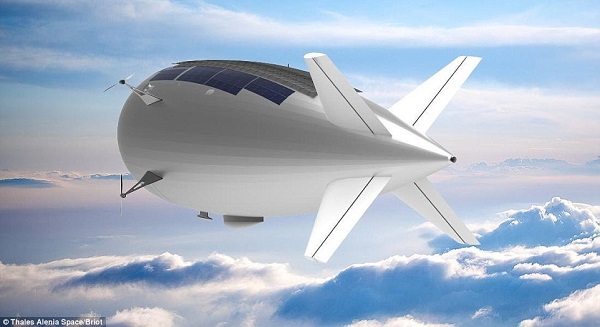 Source: Daily Mail – dailymail.co.uk
Source: Daily Mail – dailymail.co.uk
By Cheyenne Macdonald
- High Altitude Pseudo-Satellites (HAPS) would work best at an altitude of roughly 20 km (12.4 miles)
- They could maintain position for weeks on end, allowing for continuous coverage from above the cloud tops
- Experts say this could be used for monitoring the ground, and even for surveillance or emergency response
- European companies, including Airbus and Thales Alenia Space have unveiled versions of the craft
ESA is looking to harness new high-altitude aircraft that bridge the gap between drones and satellites, to observe Earth from miles above the surface without leaving our atmosphere.
These ‘pseudo-satellites’ could maintain their position for weeks on end, allowing for continuous coverage from above the cloud tops.
Aerospace firms are working on diverse concepts to bring the idea to life, including Airbus’s solar-powered Zephyr craft, which broke world records after a 14-day flight in 2010, and Thales Alenia Space’s blimp-like Stratobus.
ESA is looking to harness new high-altitude aircraft that bridge the gap between drones and satellites, to observe Earth from miles above the surface without leaving our atmosphere. These ‘pseudo-satellites’ could maintain their position for weeks on end. A concept photo is pictured.
Source: Daily MailAIRBUS’ ZEPHYR-S
The Zephyr S has been built by Airbus Defence and Space engineers.
It is powered by the sun during the day, which also recharges its lithium-sulphur batteries to power it by night.
Its huge 22.5m wingspan means it can be launched by four military personnel on their shoulders.
The £‘psuedo-satellite’ can fly at more than 70,000ft – twice the altitude of a commercial airliner.
British military forces will use the high-tech aircraft to monitor targets on the ground from anywhere in the world.
High Altitude Pseudo-Satellites (HAPS) would work best at an altitude of roughly 20 km (12.4 miles).
This region is about 10 km above where commercial airliners fly, and leaves clouds and jet streams below, and out of the way.
According to ESA, the craft could monitor the surface from the ground to the horizon 500 km away.
As they would not be subjected to high wind speeds, the HAPS could maintain their position for weeks or months at a time.
‘For Earth observation, they could provide prolonged high-resolution coverage for priority regions, while for navigation and telecoms they could shrink blind spots in coverage and combine wide bandwidth with negligible signal delay,’ said future-systems specialist Antonio Ciccolella.
‘ESA is looking into how these various domains can be best brought together.’
Several European companies have been working on their own HAPS systems.
High Altitude Pseudo-Satellites (HAPS) would work best at an altitude of roughly 20 km (12.4 miles). Airbus’ Zephyr-S could carry small payloads for three months at a time, while the larger Zephyr-T could carry bigger payloads. The firm broke a record in 2010 after the Zephyr achieved 14-day continuous flight.
Source: Daily MailAerospace firms are working on diverse concepts to bring the idea to life, including Airbus’s solar-powered Zephyr craft and Thales Alenia Space’s blimp-like Stratobus (pictured above, in an artist’s impression).
Source: Daily MailAnd, ESA is working to investigate the potential of these types of craft.
Airbus’ Zephyr-S could carry small payloads for three months at a time, while the larger Zephyr-T could carry bigger payloads.
Thales Alenia Space’s Stratobus, which is set to take its first flight in 2021, can carry payloads up to 250 kg, and uses electric engines to fly against the breeze.
Just last month, over 200 HAPS experts met in Europe to discuss the technology.
As they would not be subjected to high wind speeds, ESA says the HAPS could maintain their position for weeks or months at a time. The record-breaking Zephyr is pictured.
Source: Daily MailSource: Daily Mail
‘We’ve been looking into the concept for the last 20 years but now finally it’s becoming,’ said Earth observation specialist Thorsten Fehr.
‘That’s come about through the maturing of key technologies: miniaturized avionics, high-performance solar cells, lightweight batteries and harness, miniaturization of Earth observation sensors and high-bandwidth communication links that can deliver competitively priced services.’
The craft could be used for precise monitoring and even surveillance, according to ESA.
‘There’s obvious potential for emergency response,’ said navigation engineer Roberto Prieto Cerderia.
Thales Alenia Space’s Stratobus, which is set to take its first flight in 2021, can carry payloads up to 250 kg, and uses electric engines to fly against the breeze.
Source: Daily Mail‘STRATOBUS,’ THE DRONE-SATELLITE HYBRID
Thales recently announced the kick-off of its Stratobus researcher and development project, in which they received 17 million euros to cover a 24-development phase
Called Stratobus, this 100-meter-long autonomous blimp is describes as a mix ‘between a drone and a satellite’.
Thales Alenia Space is designing this ship for both civil and military applications, with a focus on surveillance and environmental management.
Solar panels are spread over the top of this high-tech autonomous blimp, which generate power for the electric propulsion system, reports RT.com.
This system will allow the ship to maintain a stable position in wind gusts up to 90 km/h, in which it uses two electric motors on either side to keep it in position.
Stratobus can hover 20 kilometres in the air, which allows for a view range of about 500 kilometres, over its theater of operations and in the lower layer of the stratosphere, which offers sufficient density to provide lift for the balloon.
It will also soar high into the stratosphere, reaching altitudes of 20,000 meters.
The plan is for this ship to carry out arrange of missions including surveillance of borders or high-value sites, on land or at sea, security, environmental monitoring and telecommunications.
Stratobus has an operational lifespan of five-years and only needs ground maintenance just a few days a year.
The ship can hold up into a 40-foot container for easy storage and transportation.
‘They could also be employed semi-permanently, perhaps extending satnav coverage into high, narrow valleys and cities.’
HAPS could work in support of existing satellites, and pave the way for other space technologies through high-altitude flight tests.
Once demonstrated, the experts say they could be efficient and cost effective.
‘We have to fly them,’ said Alvaro Rodriguez of the EU’s Satellite Center.
‘The technology is there, all the ingredients are there, now it’s time to mix them into a nice recipe.’
Source: Daily Mail – dailymail.co.uk





